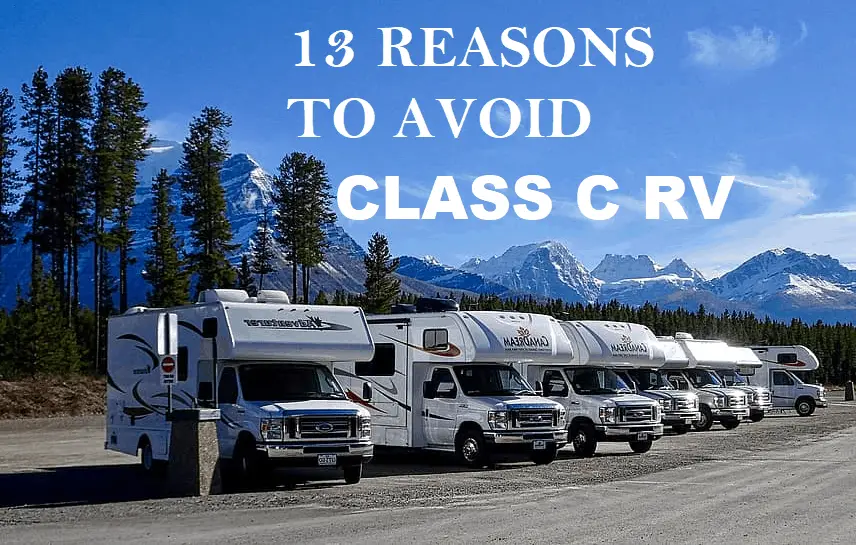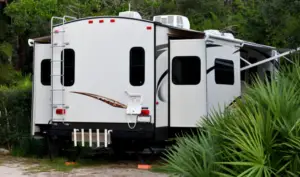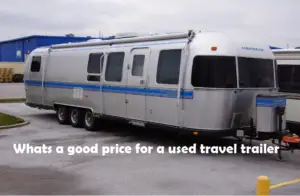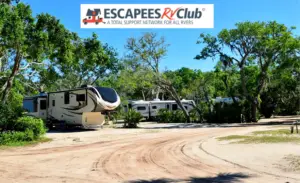In this article, we will see different disadvantages of class c motohomes and why one should avoid them. So, are class C RVs reliable? We will find out.
There are a lot of reasons to buy a Class C RV but to get the right picture, you need to see the other side of the coin. Not everything is rosy with the Class C RV and there are good reasons to avoid buying one.
Lets see 13 reasons why not to buy a class c motorohome.
1. High cost Of Ownership
Let’s get this one out of the way right away as everyone is concerned about how much RVs cost.
While a Class C is cheaper than the Class A or B it is still very expensive to buy. The average cost is around $65,000 and the price you pay depends on the manufacturer.
Brand new class c motorhomes cost on average cost between $50,000 to $100,000. That’s a lot of money and a big investment.
But for what you get in amenities and convenience with a Class C you can also get in a good travel trailer at half the cost or less. Pulling a trailer is not that much more difficult than driving a Class C rig. Sometimes it is even easier as you can park the trailer and use your tow vehicle to get around town.
As Benjamin Franklin once said, ‘a penny saved is a penny earned.’ In the RV world keeping up with the Joneses is one way to ruin your retirement. Being economical and meeting your budget is not wrong.
Sales and property Tax
When you buy an RV you also have to think about the sales tax and property tax associated with it. The sales tax can be anywhere from 6% to more. It depends on where you buy the RV.
You may also have to pay property tax on RV yearly depending on how you file the taxes.
Here is the average cost of other towable RVs that are little smaller:
Travel trailers : $15,000 to $28,000
Pop up campers : $10,000 to $18,000
Tear drop trailers : $8000 to $12,000
Truck camper : $20,000 to $35,000
2. Extra expenses
Driveable RVs have this in common. When you have maintenance to be done you are going to be needing someplace to stay.
You can’t sleep in your Class C while it is in the shop. This may be okay if you are not using the vehicle at the time of the repairs but if you are, you are looking at spending extra money for a hotel room.
Then if you did not tow your car behind the rig or include a toy hauler, then you will be looking at renting a vehicle to get you around town while you wait for your Class C to be fixed and road-ready again.
The extra expenses could cut your vacation short and ruin your time away from home. Unless you budgeted for repairs before you left.
Insurance cost
Owning a big RV like class c motorhome means you will need compulsory insurance. And the cost of insurance isn’t cheap. ON an average class insurance cost is between $800 to $1000 per year. You will agree this isn’t less and in fact it can go up depending on lot of factors
Maintenance Cost
Unlike travel trailer or fifth wheel, motorhomes have engine to maintain. As long as you are on warranty, it should be fine but beyond that regular maintenance will cots a lot.
Customization and interior changes or repairs
If you buy a pre-owned or used motorhome than every aspect of the motorhome will not suit you and in that case you are ought to make the changes. The changes in the motorhome interior can be costly. An old sofa or a bed replacement can cost you in thousands.
3. Access difficulty in cab over sleeping area
In the pictures this spot looks great. You envision extra living quarters because the children’s bedroom is over the cab and not taking up any space. The reality is that the access to this space can be quite difficult even for children.
Getting in and out of bed may be harder than you thought and there is a small risk that someone might slip and hurt themselves. Then the lack of headroom is another issue. If someone forgets where they are sleeping, they could get up and bang their heads on the ceiling.
This is not to mention any night time duties that can arise when one is on the road. Going to the bathroom in the middle of the night is made more difficult because of the difficult entry and exit point.
While the Class C may be more economical than some of the other driveable options it does come with some issues you need to think about before you buy.
4. Difficulties in towing a car
This can be done as you do need mobility once you find a great place to park. Not every site you want to see or shop at is RV accommodating, even for a smaller Class C RV. You will find it difficult to park your rig when you need to go shopping at the supermarket, etc.
Towing a vehicle behind is like towing a trailer and you will run into similar difficulties especially when you need to park your RV in a camp spot. There is a lot more work involved and when you are on the road, your gas mileage plummets because of the extra weight.
Then you have to fill the tank on the vehicle you are towing adding to your expenses. Plus, if that vehicle breaks down you are looking at extra expenses. It is something to think about when looking at a Class C RV.
So, can you tow a car with class c motorhome?
Well, the answer is definitely yes. You can, but it depends on the motorhome weight rating and also on, how much your car weighs.
Towing a car behind a broad motorhome can be a little hard thing to do if you are new at it. But, even then people do tow cars behind. Specially, when you are full time living, it can be little hard to RV without a car.
Most class C motorhomes can tow upto 5000 lbs. Bigger and high end super class C RVs have much higher towing capacities that can be as high as 30,000 lbs. RVers not only tow cars but also tow other things like boats.
5. The ride may not be great
The more expensive RVs, like the Class A & B, are provided with top-notch frames and suspension systems. Their rides can feel as smooth as sliding on glass. The extra purchase cost gives you access to this top luxury.
However, most Class C RVs are built on F450 or 350 frames. These are normal pick up truck frames and their suspension and ride feel about the same.
Going down the road it feels like you are driving a pick-up truck and you also feel every bump, rise, or crevice in the road.
If you want a comfortable ride, you should look to other classes of RVs and avoid the Class C. Going down dirt roads that have potholes will give you an experience you would rather forget. Comfort is not limited to just the amenities you have in the rig but ap[plies to the ride as well.
6. Not great on gas mileage
For their size, Class C RVs do fairly well in getting the most out of a tank of gas. But they are not that great when compared to the Class B RVs which get better gas mileage across the board.
The average gas mileage you will get using a Class C is about 18 MPG but that is not including the extra gear weight, the weight of the vehicle you are towing, and other issues that arise to cut your mileage down.
Most Class Cs are not aerodynamic in design. They can’t be when they have that cab over sleeping area. Wind resistance will cut your mileage and make it harder for you to steer the vehicle.
While there are some exceptions to that rule, don’t count on boosting your gas mileage that much when you address those issues.
On an average they have gas mileage of around 8 to 10 only. This can be tough on your monthly budget. If you compare this with class B or travel trailer then its much less and costly.
The mpg of class c is still better as compared to class A which gives mpg of around 5-7 on an average. Class B motorhomes have the highest mpg and they can run 18 to 20 miles per gallon. That’s pretty good with class b but they are compact and much smaller than class c motorhomes.
What impacts mpg
Things that normally impact the mpg directly are speed, weight, road grade and the grade of gas. Weight is obviously higher in these motorhomes but they are also not great in terms of aerodynamic designs.
Some travel trailers are designed very nicely to be aerodynamic but same is not possible with motorhomes which therefore puts them in high gas consumption category.
Improving the miles per gallon
While some things like regular maintenance, properly inflating tires and using less air conditioner can improve the mileage but still it will be in this range only. The main reason is obviously the weight and how bulky these RVs are.
They are second to the largest to class A motorhomes. In terms of features and amenities they do have all of those but its also affecting the mileage. And that means you go more often to a gas station.
Don’t want to spend much on gas? Park your class C at campsite for longer durations and enjoy the stays.
7. Road noise
Remember when we said that this is a truck frame and you will feel every bump n the road? Well, you will also hear a lot more and that won’t be because you turned your radio up.
The engines on a Class C are noisier than the ones you get in a pick-up truck and because the chassis is an all in one design, you will hear the noise the engine makes. That sound is not pretty. Plus, you may hear the air conditioner as well.
The reason for this is that the cab is not insulated like it is in a normal pick up truck so the noise is not muffled like it should be.
Try turning the radio up and see if you can drown the noise out but you may not be able to have a good conversation with your traveling partner.
8. Reduced living space
A Class C RV may look big and they do come in lengths ranging between 21 and 40 feet but inside is another story. Because of what is included in the RV portion of the vehicle your living area may be smaller than a travel trailer’s which ranges in length between 10 and 36 feet.
You can’t count the cab in a Class C as part of your living area so you are losing that space off the 21 to 40-foot size. With travel trailers, you are not losing any space to driving areas and this maximizes the room you get to move about.
A 30 foot Class C does not have the same amount of living space as a 30-foot travel trailer. Teardrop trailers are about the only travel trailer that has less room than a Class C RV.
On an average class motorhomes sleep 6-8 people. You will also find bigger models that sleep more people.
Still better than smaller RVs
Even then i would say class c still better than some of the smaller travel trailer or class b Motorhome. The main reason why class C can still do better is because of the slide outs they come with.
Slide outs are great but they can still demand more attention. You need to lubricate them and do regular maintenance. Also, you need to be careful while extending, retracting them. Any debris on top can get them stuck while retracting.
9. Storage space issues
Not only do you get less living space with a Class C RV, but you also get less storage space. The Class A and travel trailers have far more places to store your gear, clothes, and essential items.
That is due to the availability of the different floor plans the travel trailers and Class A RVs come with. The limited floor plans for a Class C greatly reduce the amount of available space left over to store those needed items.
The only RVs that may have less storage space than the Class C would be the teardrop trailer, the pop-up camper, and the Class B RV. If you are bringing the kids along for the ride, that is still not going to leave you much room to store your needed clothing.
Not to mention you won’t be able to buy all those neat souvenirs that remind you of your great journey.
External storage in class c can also be less as compared to bigger class A and fifth wheels. This however may not be true with all class C RVs. In fact, some of the things like maintenance, storage or space can be sometimes better in class c rather than towables. Therefore, storage or space can be both pros and cons for class c RV. It depends with which RV you are comparing them against.
At around 30-34 feet they are in middle in terms of most aspects as compared to other RVs (class A, class b travel trailer or fifth wheels).
10. Leveling issues
This is one of the practical issues you have to contend with every day you are on the road with a Class C. Leveling your RV is vital as your appliances do not work that well when you are on a tilt.
Class C RVs usually do not come with automatic levelers, there are a few that do, and that is because the automatic levelers take up too much space and the Class C is too low to the ground to accommodate those tools.
Manually leveling your RV is difficult and can be cumbersome. Plus, it is easy to make a mistake and not get the rig as level as it should be.
Automatic levelers come in handy and save you a lot of work and time. Also, they do get the rig as level as it should be. It is your choice how you want to spend your vacation time.
11. Have to deal with roof issues
Another problems with class C RV is roof issues. Generally, Class C RVs do not come with a very durable roof. For the most part, they are made of rubber and that construction material is not that great against the elements.
Not only are you facing repair or replacement costs eventually with a rubber roof you may not get the waterproofing you need to protect your interior.
It will depend on how you treat your roof and if you scrape it a lot against low lying branches.
Or you can pay the extra cost and get a fiberglass roof. These are stronger than rubber and have a longer lifespan. The good news is that you actually get a choice with some manufacturers.
For the most part, you will be stuck with a rubber roof which makes making repairs to air vents, AC motors, and exhaust pipes a lot more difficult.
Water damage
Any leaks in the overhead cab area roof can be very bad. It can result in water damage and cause all sorts of other issues due to water damage.
If you are planning to buy a used or old class c rv then be sure to check the roof thoroughly. It can turn out to be a very bad deal if there is any leakage in the roof. Roof replacement or repairs can be hard and costly too.
A regular maintenance like cleaning, removing debris, sealing seams can keep the roof in good condition.
But, even then with time the roof can become notorious and start to leak. This happens with most old RVs specially when they are not maintained properly.
12. High depreciation
Resale value is important if you do not foresee yourself buying one Class C RV and sticking with it for 20 years or more. The better the resale value the better it is for you. Unfortunately, Class C RVs do not hold their value very well.
These rigs depreciate faster than Class A RVs in most cases. Not all as there is some top of the line Class Cs that do hold their value over the years.
To find out which ones do that takes a little research on your part. There are a lot of models of Class Cs and depending on the features you order the resale value can remain quite high.
Class C RVs depreciate about 35-40% in 5 years of time. If i was to compare them with other motorhomes yes they are still better but still the depreciation is much higher. The moment you get them on road they start loosing the value.
This also gives you an opportunity to buy used at much lower price. Buying used has its own cons though. You may end up buying a lemon that can be complete waste of money.
Here is an average depreciation in class c motorhomes:
1 year : less than 8%
2 years: depreciates around 22%
3 years : depreciates around 26%
4 years : depreciates around 28%
5 years : depreciates around 38%
10 years : depreciates around 52%
20 years : depreciates around 85%
Beyond 30 years it will be valued much less to around $4000 or less. But, it may not be worth it to buy such a big motorhome that is so many years old. The primary reason is roof condition and also their maintenance needs.
Here are some top class C RVs brands that hold their value and have better resale value.
- Jayco
- Forest River Forester
- Thor Quantum
- Coach House Platinum III
- Entegra Coach Esteem
- Winnebago
- Tiffin
13. Reduced driving visibility
There are two other reasons why you should avoid buying a class C RV. One, the driver’s visibility is low. Not only does the cab over restrict your view but the RV portion of the rig is wider than the cab making it harder to see down the sides.
Two, the driver’s and passenger’s seats do not rotate cutting down on living space. They are fixed for the occupants to see forward only. Plus, they are usually lower than the floor of the RV portion and boxed in by little walls.
Those seats are only good for driving and nothing else. It is a waste of potential living space and cuts down on everyone’s comfort zone.
Parking a class C RV also takes more space as they have higher width. Their overall length, width demands big garage too and also, special storage during winter and off seasons.
Boondocking
Long duration boondocking is possible with class c due to better water storage, bathroom/shower and power as compared to other small travel trailers or pop up truck campers. But, they are broad, lengthy and are therefore not suited for less accessible regions.
So overall, are class C RVs all about disadvantages? Obliviously NOT!
There are several good things that are advantageous to them. In fact, they seem to be perfect RV for a slightly higher price and good amenities.
There are several top brands that manufacture class c motorhomes. Most popular and best class c RVs include below :
- Coachmen Freelander
- Winnebago View
- Tiffin Wayfarer
- Jayco Melbourne
- Forest River Sunseeker
Class A can be sometimes beyond reach and lower end RVs do not have all home like features. Yet, you need to be careful with class c’s as they do cost a lot and you may end up having something that is not your type.
So, revisit all the cons above and see the factors that tell you why you should avoid them.
What should you opt instead of a class C RV ?
If you still prefer buying a class c RV then do check out these great options that come at affordable price.
Well, it depends on what reasons from above made you think the most.
If the cost seems high then go for a larger travel trailer that will give you similar living space, storage and yet come at a much lower price. But, you have to deal with towing it behind a car or truck.
If you think the storage and sleeping capacity in class c wont be sufficient then go for a bigger class A motorhome or a longer fifth wheel or even super class c motorhome. Other limitations like length, width, and parking issues due its size can be eliminated by getting a smaller class B motorhome.
Do class C RVs come with slide out?
Yes, most class C RVs come with slide outs. They are enough lengthy to have multiple slide outs. You will also find models with more than 1 slide on either ends.
Do class C motorhomes have multiple bedroom, bathroom?
Yes, many class c motorhomes come with 2 bedroom and bathroom too. You get both gas powered as well as diesel powered class c RVs.
Do Airstream make class C motorhomes?
Airstream are luxury RV makers that are mostly known for their travel trailers. People normally recognize them by their shiny aluminum trailers. Airstream do make class C RVs as well. Interstate and Atlas touring coaches by Airstream are luxurious, spacious and popular motoromes.
Conclusion
These are just some of the reason why you should not buy a Class C RV. There are others, like rider visibility, cab over leakage, and a lack of air conditioners.
Check out the Class C RVs and do a thorough comparison with the other options available and see the difference.





